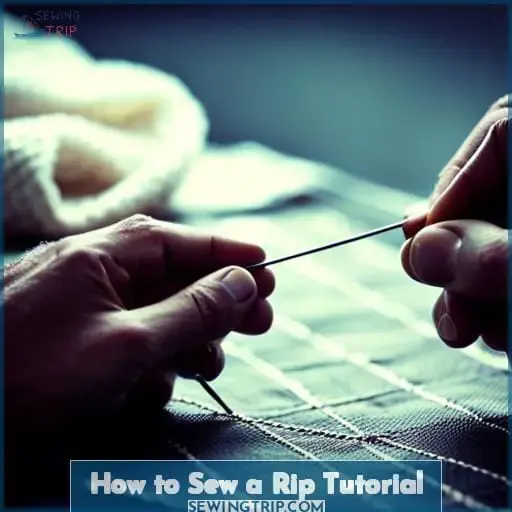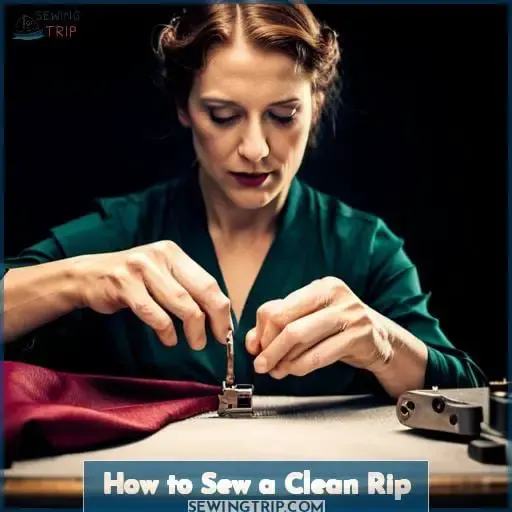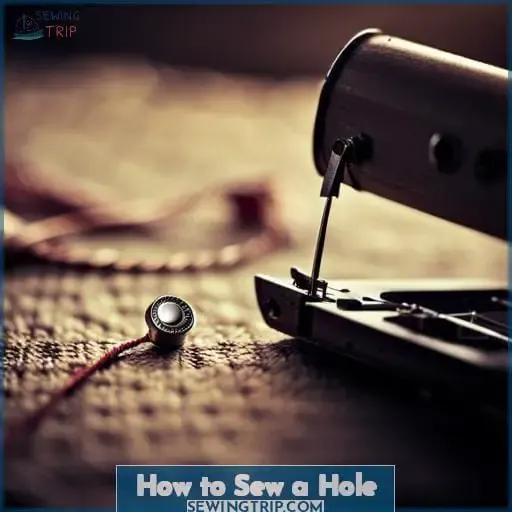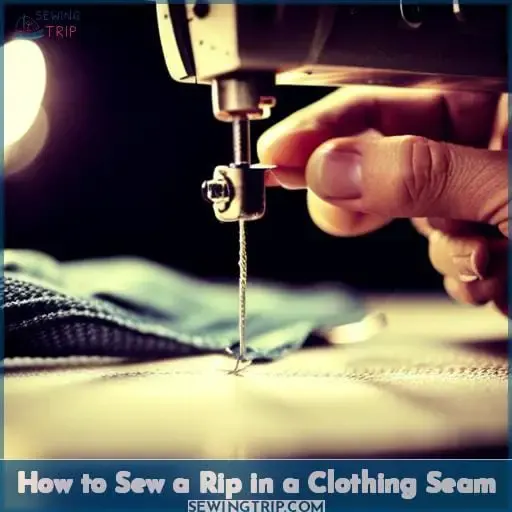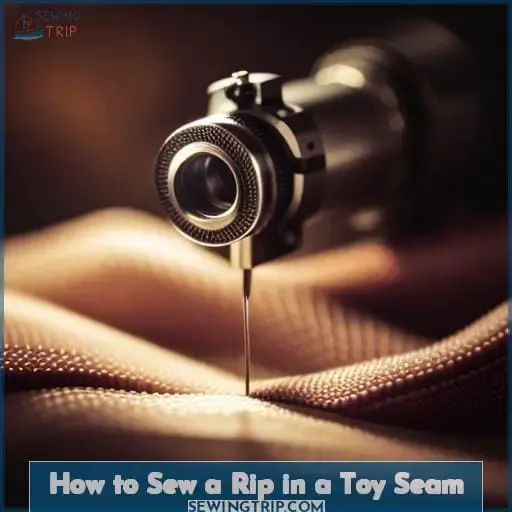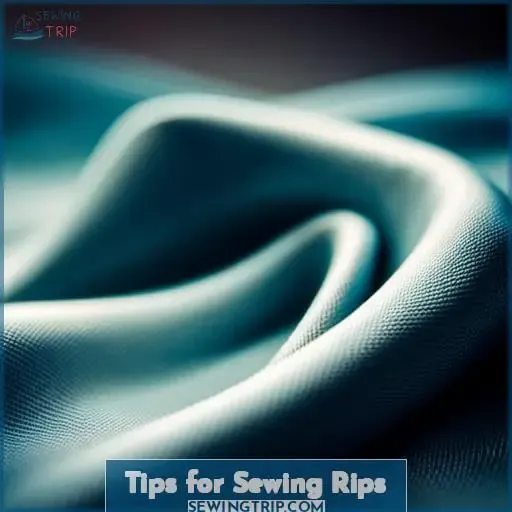This site is supported by our readers. We may earn a commission, at no cost to you, if you purchase through links.
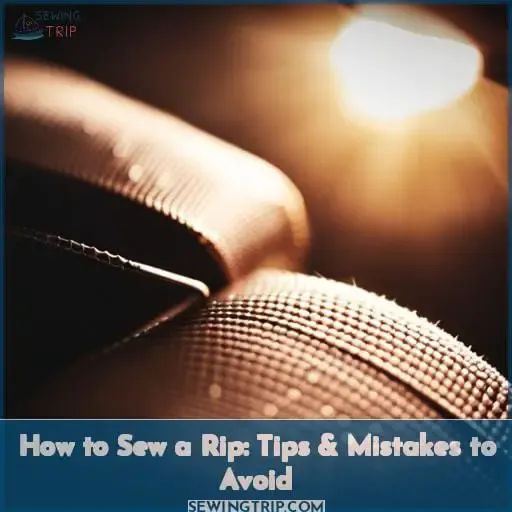 A rip in your favorite clothing item or toy can be dreadfully disheartening. But never fear, the skill of how to rip sew is something that anyone can learn with a bit of practice and patience!
A rip in your favorite clothing item or toy can be dreadfully disheartening. But never fear, the skill of how to rip sew is something that anyone can learn with a bit of practice and patience!
Sewing up rips doesn’t have to be as daunting as it seems. All you need are some basic tools, a few tips and tricks for success. In this article we’ll look at how to sew a clean rip, hole or seam in fabric items.
So grab your needle and thread – let’s dive into stitching up those pesky little tears! First, you’ll need a needle and thread that matches the color of your garment as closely as possible. Make sure to thread the needle and knot the end. Then, turn the garment inside out to hide knots and uneven stitches.
Carefully pin the edges of the rip together so they align evenly. Begin sewing by pushing the needle up from the back of the fabric and making small, neat stitches just along the edge of the rip.
Once you’ve sewn all along the length of the tear, tie off and cut the thread. For extra reinforcement, you can sew a second line of stitching parallel to the first.
A few tips: go slowly, don’t pull too tightly on the thread, and change your needle often.
Table Of Contents
Key Takeaways
- Use a matching needle and thread for repairing rips in clothing and fabric items.
- Turn the garment inside out to hide knots and uneven stitches.
- Pin the edges of the rip together evenly before sewing.
- Consider using fusible interfacing to reinforce clean rips before stitching.
How to Sew a Rip Tutorial
You’ll be stitchin’ those tears closed in no time once you get the hang of these easy mendin’ methods.
For quick fixes, reinforce the tear with fusible interfacing before using a zigzag or ladder stitch.
Patchin’ up holes is a cinch – just cut a scrap of fabric larger than the hole, pin it underneath, and sew the edges down with a straight stitch.
Seam rips are no drama either – line up the edges, then sew along the existing seam line by machine or backstitch by hand.
To restore your tired garment to its original glory, take the time to iron the area flat and trim loose threads before stitchin’ your repair.
With a few essentials like needles, thread, scraps, and an iron, you’ll be rip sewin’ those rips closed and givin’ your fave clothes a new lease on life.
How to Sew a Clean Rip
When repairing clean rips, you can choose between hand stitching and machine stitching techniques. For machine stitching, use a straight stitch, zigzag stitch, or a combination of both to neatly repair the rip.
For hand stitching clean rips, thread a needle doubled and knot one end. Then, insert the needle at the bottom of the rip and take small, vertical stitches while tapering off at the top.
Machine Stitching
When stitching over a clean rip by machine, experiment with different stitches like a straight stitch, zigzag, or combo to see which technique best reinforces that area.
- Seam Ripper Selection: Use the appropriate seam ripper size for precision ripping.
- Stitching Speed Control: Adjust your sewing machine‘s speed according to your comfort level and control requirements.
- Thread Tension Adjustment: Optimize thread tension settings for balanced stitches without puckering or loose loops.
- Fabric Compatibility: Choose needle types and sizes suitable for the fabric you’re working with.
- Stitches Removal: If needed, use small scissors or tweezers to carefully remove any unwanted stitches.
By following these techniques and tips when using a sewing machine to mend clean rips in garments, you can achieve professional-looking repairs while preserving the quality of your fabrics.
Hand Stitching
Stitching by hand lends a personal touch, like a grandmother mending her grandchild’s favorite dress with neat little stitches full of love. To hand stitch clean rips, thread a needle doubled and knot one end. Take small vertical stitches starting at the bottom of the rip, tapering them off at the top.
Choose a thread color matching the fabric. When patching holes, reinforce edges first with fusible interfacing. Use running stitch, backstitch, ladder stitch or blanket stitch for an invisible mend. With practice, hand stitching becomes a creative, soothing method to repair well-loved clothing.
How to Sew a Hole
Pin a matchin’ patch under the hole before tackin’ it in place by hand or machine. When repairin’ holes, start by ironin’ the torn area and trimmin’ loose threads without makin’ the hole bigger.
Then, cut a patch from matchin’ fabric and pin or baste it underneath, makin’ sure to match patterns. Next, stitch around the edges of the patch with a zigzag or straight stitch on your machine. Or sew it by hand usin’ a runnin’ stitch, backstitch, or blanket stitch if you want.
Be sure to trim off any excess fabric from the back once stitched. Press that repaired hole when you’re done for a crisp finish.
- Use similar weight and type of fabric for patch
- Trim patch close to stitching so it doesn’t bulk up
- Knot threads securely for hand sewing
How to Sew a Rip in a Clothing Seam
You’ve learned how to mend a hole in your clothing, but what about those annoying seam rips? Seamstress secrets to the rescue! Whether it’s a tear in your fave jacket or a rip in your cozy coat, mastering the art of sewing a rip in a clothing seam is a valuable skill.
Here are some stitching tips and sewing techniques to make it a breeze:
- Assess the Damage: Carefully examine the rip to understand its size and location within the seam.
- Prepare Your Tools: Grab your trusty sewing machine or needle and thread. Choose a thread that matches your fabric for seamless repair.
- Realign the Seam: If the rip has caused the seam to come apart, align the fabric edges and pin them in place.
- Stitch with Precision: Use a straight stitch on your machine or hand-stitching techniques like running stitch or backstitch.
- Press for Perfection: After sewing, press the repaired seam with an iron for a polished finish.
With these sewing techniques, you can restore your ripped clothing seam with confidence, whether it’s a beloved denim jacket or a cozy couch cover.
How to Sew a Rip in a Toy Seam
- Use a ladder stitch. This nearly invisible stitch looks just like the original seam when done properly.
- Try a whip stitch for extra strength. It creates a sturdy seam that handles playtime wear and tear.
- Opt for a slip stitch on delicate materials like fur. It produces an inconspicuous seam without damaging fragile fabrics.
- Reinforce stress points. Consider adding an extra seam or stitches at joints or other high-tension areas prone to ripping.
With some basic sewing skills and supplies, you can give damaged toys new life. Proper stitching techniques like the invisible ladder stitch will get your st■ friends ready for more fun. Toy seam repair preserves cherished playthings and teaches useful mending skills.
Tips for Sewing Rips
Step lightly when mending garment tears, lest your ham-fisted handiwork hasten their ruin. When sewing repairs, choose a thread that matches the garment closely. Use small, tight stitches and don’t pull too tightly or you may cause puckering.
Patch wider openings with a scrap of coordinating fabric, neatly trimmed and gently secured with blanket stitch around the edges.
For straight rips, gently iron the edges flat before neatly running stitching along the original seam line. With care and proper technique, your clothing can be restored without a trace of damage. Seam rippers, minor mending, and patience with the process will prolong your beloved wardrobe.
Common Mistakes to Avoid When Sewing Rips
It’s heartbreaking when your stitches come undone and your lovely creation rips apart. Avoid frustration by selecting the right needle and thread for your fabric. Properly adjusting thread tension prevents popped seams.
Carefully position patches underneath holes, pinning them first. Blanket stitching edges adds extra strength and durability.
When mending jeans, use denim needles and polyester thread. Checking stitch length prevents more ripping. An invisible stitch blends the repair. Investing in quality seam rippers avoids damaging material.
With care and patience, properly sewn repairs withstand wear and tear. Mend, don’t end – breathe new life into damaged clothing and linens with smart techniques.
Conclusion
Like a masterful architect, sewing a rip is a delicate task requiring skill and precision. With the right knowledge and some practice, you can easily repair any type of rip – from a clean rip to an open hole to a clothing seam rip.
Remember to reinforce edges with iron-on interfacing or fabric for extra strength, and press the repaired area to flatten it.
When sewing rips, use the correct stitch and techniques, and avoid common mistakes like using too much thread or making the rip too wide.
With these tips, you can be confident that you’ll be able to fix any rip and extend the life of your clothing.

